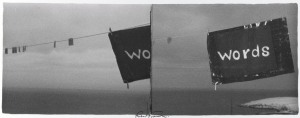Termite Art
Working the edges and angles. “Part of the woodwork,” they say, though not in a structural sense – rather more a destructural or deconstructional way, one should probably add. We’re usually fairly quiet, but work is constant, at times involving even groups or clans. What we create looks like a whole full of holes. Feeding on the solid, reducing it to doubtful tunnels, leaving some beautiful patterns. Rhythmic, at least. Once in a while you can hear the hum of our work, but more often than not our efforts are simply stumbled upon.
What you once thought sturdy enough to lean upon often crumbles out from under. Usually we’ve been there first and found the flaws. We scramble and burrow, many even fly. Keeping mostly to ourselves, gnawing and chawing away at the things we all believe in and trust, things assumed to hold fast and true, the shapes that give substance to lives.
Of course many consider us sinister nuisances, think we work to undermine, but we really don’t take much – just leave it considerably different than when we first come upon it and passage our way through. Left to ourselves we accomplish a lot, are industrious, but we’re more often pestered, hampered, sealed-off, even (and yes, I’m serious!) exterminated! Treated as pests or threats or dangers.
We might be admired, theoretically, but we’re never welcomed as guests. Not invited in houses where public or money are smelled. There we’re only talked about – as worming and wriggling our ways through the infrastructures – “fluttery, ephemeral critters” we’re called – parasitic to power and ultimately debilitating if left unconfronted.
Harmless enough as ourselves, simple units to squash, but we happen to be many. Think: ants. Think: pestilent plague.
We can be quite beautiful in the light (as a specimen!) – translucent and fine and opaque, exhibiting a powerful delicacy. But given free reign we undo the foundations, and therefore, it is feared, the whole edifice too. An elephant, for instance, might be trained – used for tricks or for jokes – is easy to keep an eye on, but not us “weasly and scuttling creatures,” no, no.
All I’m saying is that some of us are always eating away at the edges and bounds, plundering thresholds, slobbering the barriers and gates – they’ll acknowledge us if forced to – but with a mind to be rid of. If featured, we watch out for the shadows and sprays, closed quarters and boots. They’ll let us have slush piles and compost, a few trimmings or what’s already abandoned, but it’s always in hopes – always – of keeping us OUT. Mark my words, no one really loves a thriving insect but itself. Grind and tear with all you’ve got, our lives are short and there’s much to do.
Requiring so little, any medium will do, only to find access…and…wizzle inside…
“A peculiar fact about termite-tapeworm-fungus-moss art is that it goes always forward eating its own boundaries, and, likely as not, leaves nothing in its path other than the signs of eager, industrious, unkempt activity.
The most inclusive description of the art is that, termite-like, it feels its way through walls of particularization, with no sign that the artist has any object in mind other than eating away the immediate boundaries of his art, and turning these boundaries into conditions of the next achievement.”
-Manny Farber-

